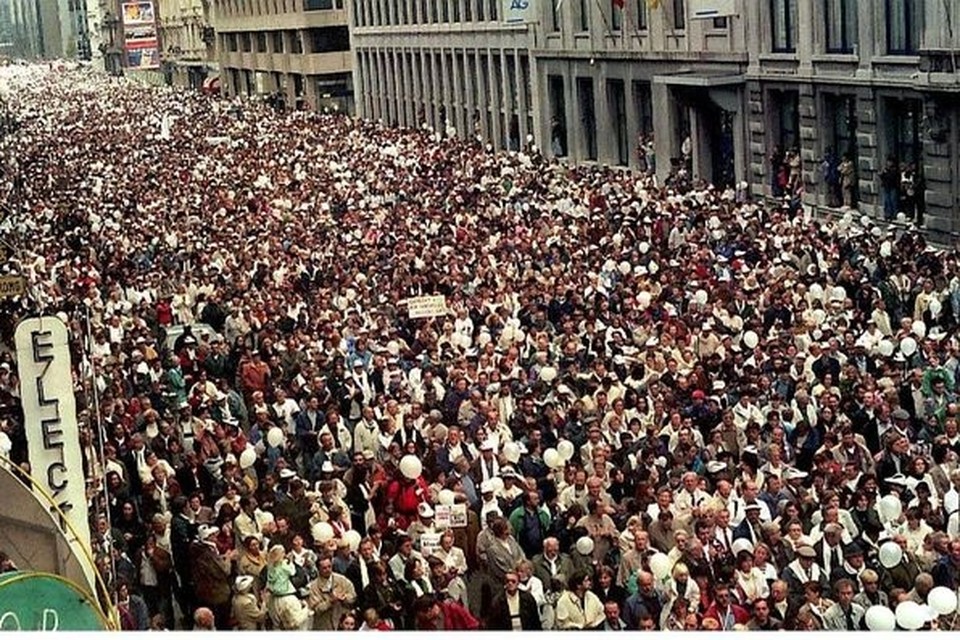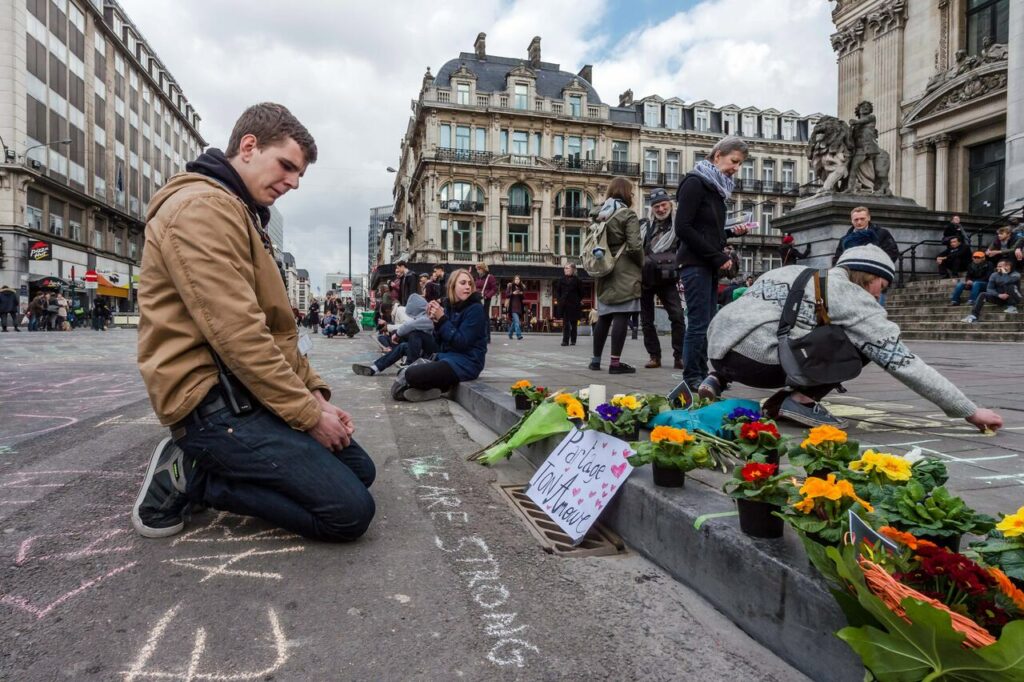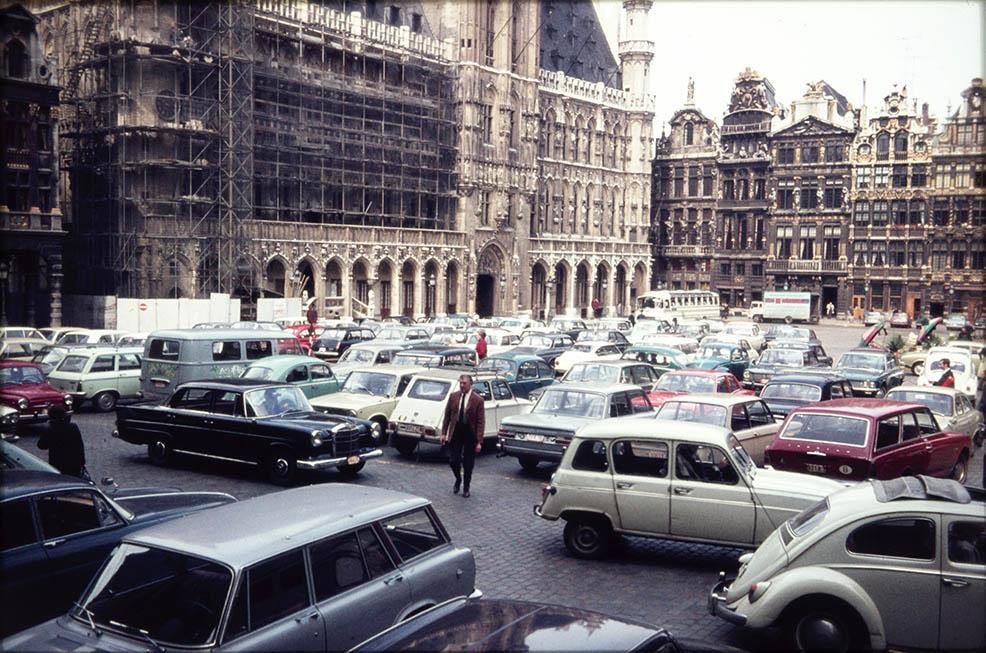Like many people new to Brussels, I expected to stay a few years. But one thing led to another. And now I’ve been living in this unruly, messy city for almost 35 years.
So how has Brussels changed since I arrived on a train from Amsterdam on a rainy November 11 holiday? And why am I still living here, rather than, say, orderly Vienna or sunny Madrid?
When I arrived, the city seemed a sleepy, joyless place. It was conservative. It was Catholic. Place Flagey was a mess. The advice you got was to move to Waterloo or Tervuren. Don’t live in Brussels. It’s awful.
In those days, most people left Brussels at 17:00 on a Friday. Some to the coast. Others to a house in the Ardennes. Without a car, or a Belgian family to visit, it could feel desperately lonely on a rainy Sunday morning.
I had moved to Brussels from Amsterdam because the Belgian (and EU) capital looked like an interesting city to explore as a journalist. Mainly because no one else considered it worth the effort to understand. Back then it was a black hole at the heart of Europe. The city tourist office occupied a single tiny office on Grand Place. The presence of the European Union (then 12 Member States) gave it a reputation as a dull bureaucratic capital. The best thing about Brussels, one French diplomat sneered, was the Friday evening train to Paris.
But it was a good time to discover this country. There were relatively unknown cities such as Liège and Ghent, and vast expanses of almost uncharted nature in the south of the country. The complexity of a country with three languages added to the challenge.

In the late 80s
It wasn’t long before the country started to change in interesting ways. I first noticed it in Antwerp under mayor Bob Cools, who reshaped the city for its year as cultural capital of Europe in 1993. He chose to pump resources into the regeneration of the derelict River Scheldt waterfront and Het Eilandje district. It was almost the first attempt at urban planning in Belgium after decades of unplanned chaos.
Drawing on neighbouring success stories
Then, towards the end of the 1990s, I began to notice that Brussels was changing. The stuffy, conservative city was renovating old industrial buildings in the canal zone. And more surprising, it had started to tolerate and even encourage street art.
It took me a while to figure out what was going on. I finally decided that Brussels was turning into Berlin, which was, following the demolition of the Berlin Wall, the most exciting city in Europe. Brussels, it seemed to me, had set out to imitate Berlin by creating artists’ enclaves in old factories and encouraging vibrant street art.
It helps to understand Brussels if you see it as always trying to copy the most successful city of the age. In the 19th century, the model was Paris, so Brussels became a city of grand cafes and wide boulevards. By the 1960s, the desirable city was New York, so the city built highways, car parks and even an office district called the Manhattan Quarter. And by the end of the 1990s, when Berlin was the place to be, Brussels gradually became cool.
But there were other darker forces around in the 1990s that suggested something was rotten in the state of Belgium. The notorious Dutroux child murders created the impression of a corrupt and broken State. The old conservative Catholic order finally collapsed in 1999 as a scandal involving contaminated chicken gradually cleared supermarket shelves of poultry, eggs and dozens of other essential foods.

The white march drew over 300,000 people to the street to condemn the way police and the justice system handled the Dutroux case
In the late 1990s, I regularly read endless international news stories that saw Belgium as a failed State. The split between Flanders and Wallonia, between left-wing French speakers and right-wing Dutch speakers, was seen as a fault line that would eventually lead to Belgium splitting in two. The country was only held together by the royal family and the Red Devils, people said.
From broken State to quietly great
Then the mood began to change. It’s hard to give an exact date but you might go for 1 June 2003 when same-sex marriage was legalised, making Belgium the second country in the world to do so, following the Netherlands. Or you might choose 28 May 2002 as the turning point, when the country legalised euthanasia, again following the Netherlands. Suddenly, unexpectedly, it seemed as if we were no longer living in a failed State, but in one of the world’s most progressive countries.
At about the same time, the identity of Brussels was changing. I had already figured out that the culture of the city changed each time the EU expanded. After three new countries joined in 1973, the British, Danish and Irish introduced their own distinctive bar culture to the city. Then the Spanish, Portuguese and Greeks arrived in the 1980s, bringing Mediterranean food and culture to the city. And in 1995, after newcomers arrived from Sweden, Finland and Austria, the city gradually began to get better government, cleaner air, and more nature in the city.
But the big change came in 2004 when ten new countries joined the EU. This brought enormous energy to the city as thousands of mainly young graduates from former Communist countries arrived in the capital of Europe. They filled the cafes and the restaurants, speaking languages we hardly recognised, and pushed the dominant language in Brussels from French to English.
By the end of the decade, the world was starting to see Brussels as a serious global city, its population drawn from Africa, Asia and America, as well as the EU countries. In a speech to the European Parliament in 2010, Joe Biden, then US vice-president, irritated Fox News by stating that Brussels, with its 1000 years of history, and its status as the home of the European Union and NATO, could legitimately be called "Capital of the Free World".
The capital of division
And then in 2016 it all suddenly collapsed. A new presidential hopeful was starting to make himself heard in Europe. In January 2016, Donald Trump gave an interview in which he hit out at foreigners in Brussels. "There is no assimilation," he said. "I was in Brussels twenty years ago, everything was so beautiful. It’s like living in a hell hole right now."
It looked like Trump might have got it right. Just two months later, in March 2016, two terrorist attacks hit the Brussels metro and the airport. While the number killed was relatively small compared to attacks in Madrid and Paris, it changed the way we saw Brussels. The city went into lockdown for the first time since World War Two, and heavily armed troops were brought in to patrol the Brussels streets.

Tribute at Brussels' stock exchange for the victims of the 2016 terrorist attacks
The disaster year continued with Brexit, which shook Europe’s confidence in a shared and peaceful future. Suddenly, there were people in France and The Netherlands seriously talking about a Frexit or a Nexit. And then, to round off the year, Donald Trump got elected in the United States, throwing everything into total chaos.
Around this time, the old theme of Belgium as a failed State began to resurface. An influential article in Politico Europe described Belgium as a "divided, dysfunctional country". But something had changed since the late 1990s and not everyone now agreed that Belgium was a failed State. Or, if it was, it was the world’s most successful failed State.
Soon after the 2016 attacks, some puzzling posters went up all over the city. "Sprout to be Brussels," they read, along with an image of a Brussels sprout. Launched by a consortium of Belgian companies, including Brussels Airlines, the campaign aimed to restore faith in Brussels with a bit of Magritte-style surrealism.
A city for people
Following the attacks, thousands of people flocked to the Bourse to lay flowers and write messages on the walls. The building became a symbolic spot to express solidarity with the victims. And the location was perfect. The empty and abandoned stock exchange had become a popular gathering place following the decision the previous year to ban cars from a large area of central Brussels.
The inspiration for the car-free zone came from a 1971 campaign to ban cars from Grand Place. Back in the car-friendly 1960s, the beautiful baroque square in the heart of Brussels had become an enormous parking lot, neatly described as the "most beautiful car park in the world". But then a group of journalists and expats launched a campaign to clear the square by holding picnics among the parked cars. At first, the burgomaster was furious. The protestors (mainly expats) were arrested. But the campaign finally succeeded.
The idea of a picnic protest appealed to the philosopher and campaigner Philippe Van Parijs. In 2012, he encouraged people to sit down with their sandwiches on the square in front of the Bourse. Thousands came with their children, cargo bikes and dogs. As a result, the city began to reconsider its controversial plan to create five underground car parks. Instead, the city developed an ambitious urban plan to create the largest pedestrian zone in Europe.

Philippe Van Parijs at a picnic protest by the old stock exchange
If I had to pick the biggest change I have seen in 35 years, it would be the shift away from cars. It is not just the centre that has been transformed. The idea has spread out to other communes, like Ixelles and Saint-Gilles. Brussels has changed from a city where cars shaped our lives to one with excellent public transport, bike lanes, and hugely expanded café terraces.
I’d have to admit that not everyone is happy. Some people are furious. And the Good Move policy might well be abandoned once the new regional government settles down to work. Some future projects might never happen now the right-wing MR is the largest French-speaking party in the Brussels Region. The city may well shelve its plan to pedestrianise Sablon square (now possibly the most beautiful car park in the world), along with the plans to restrict cars on Avenue Louise and Avenue de la Toison d’Or.
I would be sad if the city went back to its old car-based ways. In recent years, it has become a more liveable city. It currently takes its inspiration from cities like Copenhagen and Stockholm. The reason, I think, is that these cities consistently come out top in the quality of life surveys produced by organisations like The Economist and Mercer. They get high liveability scores because of low traffic, green spaces, clean air and good government. And Brussels wants to imitate these successful cities. It means we are, at this moment, living Danishly.
It's now quite rare to hear anyone describe Belgium as a failed State. It’s much more likely to see Belgium praised as a successful small democracy. Following Belgium’s presidency of the EU Council earlier this year, Ursula von der Leyen congratulated the country on its ‘extremely successful presidency’. A seasoned Dutch journalist said it was one of the most efficient presidencies he had ever witnessed.
It’s clear that Brussels and Belgium have changed enormously in 35 years. The influence of the Catholic church has faded. The two-hour-lunch is a distant memory. The empty Sunday streets are no more. We’ve come to accept and even demand bike lanes, vegetarian and vegan food, excellent coffee, interesting local beers, halal meat, good architecture, reliable public transport, efficient bureaucracy, fast internet, urban planning, shops open on Sundays, racial diversity, gay rights, and a say in how we die.
The city is now firmly at the centre of huge global changes. Just walk through the streets and you’ll see Ukrainian flags hanging from the balconies, ‘Free Gaza’ graffiti on the walls, and anti-Hamas stickers on lamp-posts. It’s no longer the sleepy, conservative capital of Belgium. The world has come to Brussels with all of its problems and anger.
It’s hard to think of one thing that hasn’t changed in the past 35 years. But you might want to mention the drache national (the national downpour) which can be counted on every year to ruin Belgian National Day. And you might want to add the surreal humour that helps us, despite all the everyday problems, to stay sprout to be Brussels.

